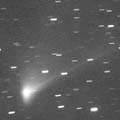
|
The condition was too bad to observe on the earth before the perihelion passage, but it was visible in the SWAN images in mid March, and in the LASCO images in early April. After the perihelion passage on Apr. 4, it appeared in the morning sky. It was so bright as 5.5 mag on Apr. 10 (Michael Jager and Gerald Rhemann), and still bright as 7.8 mag on Apr. 15 (Edwin van Dijk). The condition will get better rapidly after this. However, the comet will fade out rapidly. It will be fainter than 14 mag in mid May, too faint to see visually.
Date(TT) R.A. (2000) Decl. Delta r Elong. m1 Best Time(A, h)
Apr. 7 1 1.60 15 46.0 0.943 0.166 9 2.4 19:52 (119,-12)
Apr. 14 0 8.88 21 16.6 0.842 0.392 22 7.3 4:02 (247, 4)
|
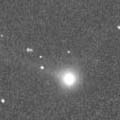
|
It passes the perihelion on Apr. 19. Now it is so bright as 7.4 mag (Apr. 12, Vitali Nevski), although it locates extremely low in the evening sky. It will be unobservable in mid April. After conjunction with the sun, it appears in the morning sky at 12 mag in June. But it locates only 20 degree high at most, and it will be fading rapidly. In the Southern Hemisphere, it appears in the morning sky at 8 mag in May, then it will be bright and observable for a while.
Date(TT) R.A. (2000) Decl. Delta r Elong. m1 Best Time(A, h)
Apr. 7 2 21.69 18 19.4 1.185 0.468 22 8.4 19:52 (109, 5)
Apr. 14 2 46.98 18 13.4 0.982 0.368 21 7.2 19:59 (110, 3)
|
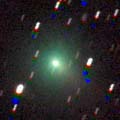
|
New bright comet discovered visually in the Southern Hemisphere. It is moving northwards fast, and it appeared in the morning sky also in the Northern Hemisphere in early April. It is getting closer to the earth, and brightening up to 7.7 mag now (Apr. 15, Edwin van Dijk). It will be observable in good condition at 7-8 mag until mid May. Then it keeps observable until it fades out in the Northern Hemisphere. It will be visible visually until July.
Date(TT) R.A. (2000) Decl. Delta r Elong. m1 Best Time(A, h)
Apr. 7 20 5.45 -31 38.5 0.676 1.107 80 8.2 4:13 (323, 12)
Apr. 14 19 44.96 -18 18.6 0.544 1.130 88 7.8 4:02 (323, 27)
|
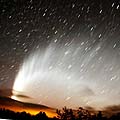
|
Excellent great comet, few times in a lifetime, for southern people. It reached to -5.5 mag on Jan. 14 and 15, brighter than Venus, and visible even in daytime. Then it appeared in the evening sky in the Southern Hemisphere and many people enjoyed a fantastic view of a beautiful great comet, a enormous curving tail with so many striae over 50 degrees. Now it is observable both in the evening and morning. It has already faded down to 9.0 mag (Apr. 11, Jim Gifford). In the Southern Hemisphere, It keeps observable almost all night until the comet has gone. It will never be observable again in the Northern Hemisphere. It passes near by the Small Magellanic Cloud in early April.
Date(TT) R.A. (2000) Decl. Delta r Elong. m1 Best Time(A, h)
Apr. 7 23 54.33 -72 30.3 1.868 1.957 79 8.7 4:13 (338,-36)
Apr. 14 0 17.52 -74 44.2 1.910 2.072 84 9.2 4:02 (341,-37)
|
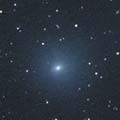
|
Although it was so faint as 13.8 mag in March (Mar. 17, Alan Hale), it brightened very rapidly in early April, and it reached to 8.7 mag on Apr. 10 (Werner hasubick). Now it is observable in excellent condition. However, the comet is very large, extremely diffuse. It is hard to observe without clear skies. In addition, it will be fading after this, will be low in the evening sky soon, and will be unobservable in late May.
Date(TT) R.A. (2000) Decl. Delta r Elong. m1 Best Time(A, h)
Apr. 7 11 3.60 -3 45.8 0.505 1.462 150 9.2 21:54 ( 0, 52)
Apr. 14 9 39.86 7 25.0 0.609 1.416 120 9.4 20:06 ( 0, 63)
|
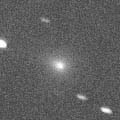
|
First return of a new bright periodic comet observed at 9 mag in 2001. It brightened rapidly also in this return. It was 16.1 mag on Jan. 11 (Filip Fratev), but it brightened up to 11.1 mag on Mar. 11 (Reinder J. Bouma). Unexpectedly, it became as bright as at the discovery, and visible visually. However, the condition of this apparition is bad. It keeps locating very low in the evening until early May. It has already turned to be fading.
Date(TT) R.A. (2000) Decl. Delta r Elong. m1 Best Time(A, h)
Apr. 7 3 32.66 11 40.7 1.724 1.114 37 13.0 19:52 ( 94, 15)
Apr. 14 4 3.73 12 37.4 1.772 1.168 38 13.7 19:59 ( 95, 15)
|

|
In this season, it has been bright as 12-13 mag and visible visually since it appeared in the morning sky in early July. It is visible visually as 12.7 mag still now (Mar. 17, Carlos Labordena). However, it is already getting lower in the evening sky, and it will be unobservable soon.
Date(TT) R.A. (2000) Decl. Delta r Elong. m1 Best Time(A, h)
Apr. 7 4 12.93 28 35.1 6.489 5.898 50 13.8 19:52 (105, 31)
Apr. 14 4 18.15 28 39.5 6.573 5.900 44 13.9 19:59 (108, 26)
|
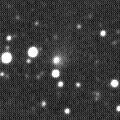
|
Now it is 12.6 mag (Mar. 9, Edwin van Dijk). It has been 12 mag for half a year since last June. But it will start fading after this. It will be too faint to see visually soon. However, the fading is slow. The comet will be fainter than 18 mag in 2008. In the Northern Hemisphere, it keeps observable until that time. In the Northern Hemisphere, it keeps observable all night for a while after this.
Date(TT) R.A. (2000) Decl. Delta r Elong. m1 Best Time(A, h)
Apr. 7 0 10.21 71 38.5 2.828 2.580 65 13.9 4:13 (200, 29)
Apr. 14 0 54.44 71 38.2 2.936 2.632 62 14.0 4:02 (199, 27)
|
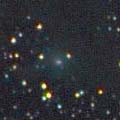
|
It became brighter than expected, and now it is visible visually at 13.4 mag (Apr. 12, Vitali Nevski). It keeps observable in the evening sky until May. It is not observable around the perihelion passage in July in conjunction with the sun. Then it moves to the southern sky, and it will be unobservable in the Northern Hemisphere.
Date(TT) R.A. (2000) Decl. Delta r Elong. m1 Best Time(A, h)
Apr. 7 4 40.36 40 33.5 2.577 2.238 59 14.3 19:52 (116, 41)
Apr. 14 4 57.42 39 34.4 2.592 2.189 55 14.2 19:59 (116, 37)
|
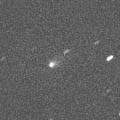
|
Now it is 14.1 mag (Mar. 20, Luis Alberto Mansilla). It has been 13 mag for a long time since last autumn. However, it will be fading gradually after this. It is observable in good condition in the Southern Hemisphere, although it is already not observable in the Northern Hemisphere.
Date(TT) R.A. (2000) Decl. Delta r Elong. m1 Best Time(A, h)
Apr. 7 16 38.86 -73 28.4 1.980 2.452 105 14.5 3:40 ( 0,-18)
Apr. 14 16 38.62 -74 4.3 1.978 2.499 109 14.7 3:13 ( 0,-19)
|
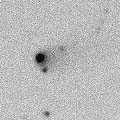
|
It has been visible at 13.5 mag for a long time since 2005 autumn until 2006 spring. Now it is fainter than last year by 1 mag, however, it is still visible visually at 14.2 mag (Dec. 22, Seiichi Yoshida). It keeps observable in excellent condition until May.
Date(TT) R.A. (2000) Decl. Delta r Elong. m1 Best Time(A, h)
Apr. 7 12 53.38 24 4.7 4.969 5.851 149 14.6 23:51 ( 0, 79)
Apr. 14 12 50.14 23 54.4 5.019 5.875 145 14.7 23:20 ( 0, 79)
|
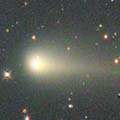
|
It reached up to 9.3 mag between October and November (Oct. 27, Juan Jose Gonzalez). It had been observable in excellent condition. But it is fading now. It has already faded down to 13.1 mag (Mar. 8, Reinder J. Bouma). However, it keeps observable after this until May when it fades down to 16 mag.
Date(TT) R.A. (2000) Decl. Delta r Elong. m1 Best Time(A, h)
Apr. 7 5 44.65 14 53.3 2.286 2.155 69 14.8 19:52 ( 77, 44)
Apr. 14 5 58.93 15 12.1 2.394 2.195 66 15.1 19:59 ( 81, 40)
|
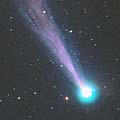
|
It reached up to 4 mag in 2006 autumn. But it had faded down to 10.5 mag on Jan. 11 (Carlos Labordena). Now it is not observable. It will appear in the morning sky again at 15-16 mag in May. Then it keeps observable until it becomes fainter than 18 mag in autumn.
Date(TT) R.A. (2000) Decl. Delta r Elong. m1 Best Time(A, h)
Apr. 7 22 46.35 -9 8.7 3.785 3.048 37 14.9 4:13 (281, 0)
Apr. 14 22 50.77 -9 29.1 3.787 3.132 43 15.0 4:02 (283, 2)
|
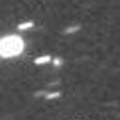
|
Now it is 15.2 mag (Feb. 24, Ken-ichi Kadota). Although it had been unobservable since last autumn, now it is appearing again in the morning sky. It will be observable at 14.5 mag from spring to summer both in 2007 and 2008. The condition is good, and it may be visible visually.
Date(TT) R.A. (2000) Decl. Delta r Elong. m1 Best Time(A, h)
Apr. 7 18 57.35 -10 37.9 5.834 5.958 92 15.2 4:13 (326, 38)
Apr. 14 18 54.74 -9 59.5 5.692 5.941 99 15.1 4:02 (331, 41)
|
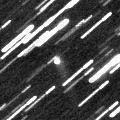
|
Now it is 14.4 mag (Feb. 12, Juan Jose Gonzalez). Almost asteroidal. It did not brighten at all since early September. Although the slight cometary activity was detected in late July, it became completely stellar soon. Its tail became visible again in late October, however, it turned to be stellar again soon. Finally it has passed the perihelion, keeping almost asteroidal. It kept observable at 14 mag in good condition in the Northern Hemisphere for a long time. However, it will be fading after this. It will start getting lower in April, and will be too low in the evening sky at 17 mag in June.
Date(TT) R.A. (2000) Decl. Delta r Elong. m1 Best Time(A, h)
Apr. 7 6 54.81 17 29.0 1.535 1.780 86 15.5 19:52 ( 63, 59)
Apr. 14 7 10.77 15 27.5 1.663 1.844 83 15.7 19:59 ( 66, 54)
|

|
Getting higher in the morning sky. Now it is 16 mag (Mar. 23, Maciej Reszelski). It will brighten rapidly after this, and reach to 9.5 mag in July. However, it moves southwards very fast in August. It is only observable until mid August in the Northern Hemisphere. On the other hand, it keeps low and hard to observe until mid July in the Southern Hemisphere.
Date(TT) R.A. (2000) Decl. Delta r Elong. m1 Best Time(A, h)
Apr. 7 23 7.28 28 49.1 2.941 2.197 34 16.0 4:13 (246, 17)
Apr. 14 23 10.63 29 39.8 2.812 2.113 37 15.7 4:02 (247, 20)
|
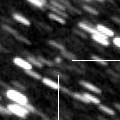
|
It brightened up to 17.5 mag in 2006 autumn, then it became unobservable. But now it is appearing in the morning sky again. It will reach to 14.5 mag in 2007 summer. However, it moves in the southen sky. In the Northern Hemisphere, it rises up to 20 degree at best in May, then it becomes unobservable in July.
Date(TT) R.A. (2000) Decl. Delta r Elong. m1 Best Time(A, h)
Apr. 7 20 49.64 -20 41.2 4.163 3.893 67 16.0 4:13 (308, 14)
Apr. 14 20 52.31 -21 40.6 4.008 3.856 74 15.9 4:02 (311, 16)
|
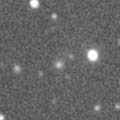
|
Now it brightened up to 16.0 mag (Feb. 21, Ken-ichi Kadota). It keeps 15.5-16 mag for one year and a half after this until 2008 summer. However, because the comet moves southwards, it is only observable until 2007 June in the Northern Hemisphere.
Date(TT) R.A. (2000) Decl. Delta r Elong. m1 Best Time(A, h)
Apr. 7 10 19.76 1 8.7 2.761 3.576 138 15.9 21:18 ( 0, 56)
Apr. 14 10 16.44 0 47.9 2.787 3.532 131 15.9 20:47 ( 0, 56)
|
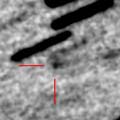
|
Now it is 17.3 mag (Mar. 11, Ken-ichi Kadota). It keeps 17 mag until May, then it will be lower in the evening sky while fading in June.
Date(TT) R.A. (2000) Decl. Delta r Elong. m1 Best Time(A, h)
Apr. 7 10 40.25 7 48.0 1.394 2.268 141 17.1 21:38 ( 0, 63)
Apr. 14 10 39.44 8 4.6 1.432 2.254 134 17.1 21:10 ( 0, 63)
|
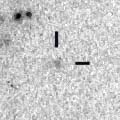
|
Now it is 17.7 mag (Mar. 12, Ken-ichi Kadota). It keeps 17 mag until July when it starts getting lower in the evening sky. It will be observable again at 18 mag in 2008.
Date(TT) R.A. (2000) Decl. Delta r Elong. m1 Best Time(A, h)
Apr. 7 14 4.27 -12 45.6 3.761 4.728 163 17.1 1:06 ( 0, 42)
Apr. 14 14 0.89 -12 32.2 3.737 4.730 171 17.1 0:35 ( 0, 42)
|

|
Now it is 16.8 mag (Mar. 25, Ken-ichi Kadota). It is outside of Jupiter's orbit. So it keeps 17 mag for a long time until 2007 summer. It keeps locating high and observable in good condition for a long time after this because it moves in the northern sky.
Date(TT) R.A. (2000) Decl. Delta r Elong. m1 Best Time(A, h)
Apr. 7 14 24.70 40 48.0 6.655 7.325 128 17.1 1:26 (180, 84)
Apr. 14 14 19.70 40 43.6 6.673 7.342 128 17.1 0:54 (180, 84)
|
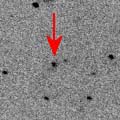
|
It was observed as 17 mag in 2006 summer. Now it is getting higher again in the morning sky. It will be observable at 16.5-17 mag in good condition in 2007 summer.
Date(TT) R.A. (2000) Decl. Delta r Elong. m1 Best Time(A, h)
Apr. 7 21 6.65 3 4.9 6.355 5.895 58 17.2 4:13 (286, 27)
Apr. 14 21 7.04 4 4.5 6.247 5.889 64 17.2 4:02 (288, 31)
|
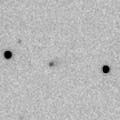
|
It reached to 16 mag in early 2006. Now it is 17.7 mag (Feb. 3, Ken-ichi Kadota). It will be fading very slowly from 17 mag to 18 mag until 2007 summer. In the Northern Hemisphere, it keeps locating high.
Date(TT) R.A. (2000) Decl. Delta r Elong. m1 Best Time(A, h)
Apr. 7 14 6.97 34 27.8 5.147 5.910 136 17.4 1:09 ( 0, 89)
Apr. 14 14 2.96 34 22.9 5.179 5.938 135 17.5 0:37 ( 0, 89)
|
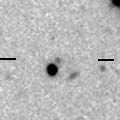
|
Now it is 17.6 mag (Mar. 17, Ken-ichi Kadota). Very far new comet, and will be observable at 17.5-18 mag more than one year after this.
Date(TT) R.A. (2000) Decl. Delta r Elong. m1 Best Time(A, h)
Apr. 7 9 36.80 -3 31.1 8.141 8.804 128 17.5 20:35 ( 0, 51)
Apr. 14 9 36.60 -3 2.5 8.225 8.803 122 17.5 20:07 ( 0, 52)
|
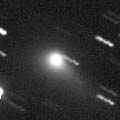
|
It has already faded down to 16.9 mag (Mar. 7, Ken-ichi Kadota). It keeps a good contition until spring, while the comet will be fading gradually.
Date(TT) R.A. (2000) Decl. Delta r Elong. m1 Best Time(A, h)
Apr. 7 9 4.16 25 38.7 4.476 4.969 114 17.6 20:03 ( 0, 81)
Apr. 14 9 4.11 25 17.9 4.641 5.032 107 17.8 19:59 ( 29, 79)
|
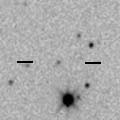
|
Now it is 18.2 mag (Mar. 14, Ken-ichi Kadota). It keeps observable in the evening sky at 17.5 mag until autumn when it becomes fainter than 18 mag, although the altitude will be getting lower after May.
Date(TT) R.A. (2000) Decl. Delta r Elong. m1 Best Time(A, h)
Apr. 7 10 15.68 16 50.4 1.113 1.938 132 18.0 21:14 ( 0, 72)
Apr. 14 10 15.09 17 30.5 1.133 1.900 125 17.9 20:46 ( 0, 73)
|
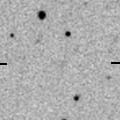
|
Now it is 18 mag. It will approach down to 0.4 A.U. to the sun in late October, and it is expected to reach to 6 mag. However, the condition in the Northern Hemisphere is very hard. It will be getting lower in the evening sky after this. The altitude becomes lower than 20 degree in early July, and lower than 10 degree in late July. The comet is still faint as 15.5 mag at that time. After conjunction with the sun, the comet will be brighter than 11 mag in late September, and will be 8 mag in mid October. But it locates extremely low, slightly over the horizon in the morning sky. It goes to the southern sky in late October, then it will never be observable again. In the Southern Hemisphere, it becomes unobservable in July. But it will appear in the evening sky at 7.5 mag in mid November. Then it keeps observable while fading gradually, although it will not locate very high.
Date(TT) R.A. (2000) Decl. Delta r Elong. m1 Best Time(A, h)
Apr. 7 10 55.04 24 7.0 2.670 3.465 136 18.0 21:52 ( 0, 79)
Apr. 14 10 45.09 25 17.6 2.672 3.379 127 17.9 21:15 ( 0, 80)
|

|
It will be observable at 14 mag in good condition in 2008 spring. Now it is still faint as 18 mag, and getting lower in the evening sky after this. But it will appear in the morning sky again at 16.5 mag in October. Then it keeps observable in good condition until 2008 summer.
Date(TT) R.A. (2000) Decl. Delta r Elong. m1 Best Time(A, h)
Apr. 7 9 15.03 42 43.1 5.106 5.513 108 18.0 20:14 (180, 82)
Apr. 14 9 14.18 42 6.1 5.152 5.463 102 17.9 19:59 (160, 82)
|

|
Peculiar asteroid moving along a cometary orbit. It will approach to Sun down to 0.6 A.U. in late April. Then it will pass very near by Earth in May. The condition to observe it is very bad. Nobody can observe it until late May in the Northern Hemisphere. In the Southern Hemisphere, it will be observable in the morning low sky from late April to mid May. It will be 18.5 mag at best if it keeps asteroidal. However, if it shows cometary activity, it may be observed at 12-14 mag in the Southern Hemisphere. Then it may be visible visually at 11 mag in the evening sky in late May also in the Northern Hemisphere.
Date(TT) R.A. (2000) Decl. Delta r Elong. m1 Best Time(A, h)
Apr. 7 0 40.61 -6 28.0 1.684 0.754 14 18.5 4:13 (262,-22)
Apr. 14 0 40.42 -7 50.8 1.510 0.672 20 18.4 4:02 (266,-19)
|

|
It had been lost since its discovery in 1986. But it was rediscovered on Jan. 9 at 16-17 mag. The condition is good in this return, and it was expected to reach to 14 mag from autumn to winter. But actually, it is fainter than originally expected, and it reached to 17 mag at best. Now it is 17.4 mag (Feb. 11, Mitsunori Tsumura). It will be fainter than 18 mag soon.
Date(TT) R.A. (2000) Decl. Delta r Elong. m1 Best Time(A, h)
Apr. 7 3 8.35 18 13.1 2.628 1.869 33 19.3 19:52 (103, 14)
Apr. 14 3 26.40 19 18.7 2.710 1.916 30 19.5 19:59 (106, 11)
|
|
![]()
 C/2006 K4 ( NEAT )
C/2006 K4 ( NEAT ) C/2006 V1 ( Catalina )
C/2006 V1 ( Catalina ) 87P/Bus
87P/Bus 99P/Kowal 1
99P/Kowal 1 C/2002 VQ94 ( LINEAR )
C/2002 VQ94 ( LINEAR ) C/2005 S4 ( McNaught )
C/2005 S4 ( McNaught ) C/2004 D1 ( NEAT )
C/2004 D1 ( NEAT ) C/2007 D1 ( LINEAR )
C/2007 D1 ( LINEAR ) C/2005 E2 ( McNaught )
C/2005 E2 ( McNaught ) 125P/Spacewatch
125P/Spacewatch C/2007 F1 ( LONEOS )
C/2007 F1 ( LONEOS ) C/2007 B2 ( Skiff )
C/2007 B2 ( Skiff ) 2006 WD4
2006 WD4 184P/2007 A1 ( Lovas 2 )
184P/2007 A1 ( Lovas 2 )![]()

























